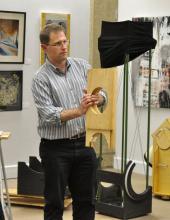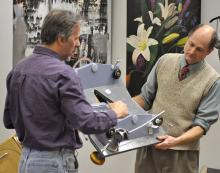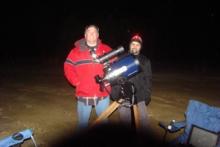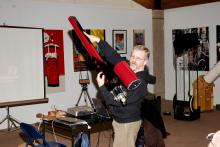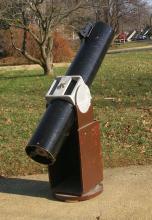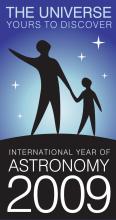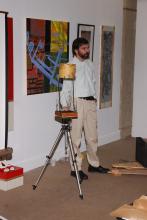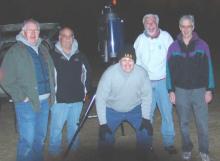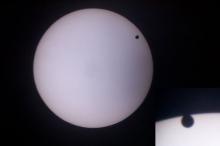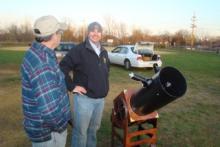Light Pollution
Light Pollution, It's Time For Action
Can anything be done about light pollution? How can all of the misdirected and excessive lighting that causes so much sky glow be avoided? Most press coverage and magazine articles present light pollution mainly as an astronomy problem, emphasizing that sky glow prevents observing the starry night sky. Many amateur astronomers feel that the key to solving the problem is this kind of awareness - and that's how to get it fixed.
As a member of the Eatontown Environmental Commission in the early 1990s, I originally presented the issue of Light Pollution (LP) to local members primarily emphasizing the impact of sky glow when observing the night sky. The reaction regarding the need for a local LP ordinance was meager, even though I also talked about glare, trespass and energy. At that time most of my information was taken from International Dark Sky literature, which I acknowledged when asked. Unfortunately, special interest organizations such as the IDA are sometimes looked upon by municipality people with some skepticism. They assume such lobby groups often exaggerate or say anything to push their agenda.
I spent the next few months educating myself by studying Illuminating Engineering Society of North America (IES) literature and talking with various IES committee members. I approached my local Environmental Commission again, but this time I concentrated my discussion on how LP affects the general public, not astronomers. My reference to sky glow was that it is a kind of "smoking-gun-evidence" of misdirected, excessive and wasteful lighting. I conducted a tour to show actual examples of existing Eatontown lighting, both good and bad, to illustrate the need for an ordinance.
There were very few existing LP ordinances available around the country that could apply to Eatontown. Flagstaff, San Diego and Tucson HAD the most detailed ordinances, but these were more applicable to astronomical observatory zones. Some did not follow a IES illuminance format (footcandles/lux). A local committee was formed to develop an ordinance based on IES recommendations that would benefit all Eatontown residents. This committee also felt that no reference to astronomy should be part of the ordinance, since it already stated that sky glow would be reduced. A series of meetings with various municipal boards and legal people followed and ultimately the Mayor and Council unanimously voted to adopt the anti-LP ordinance in 1993.
Eatontown has been regulating outdoor lighting ever since. To avoid glare, spill light and energy waste, light fixtures must be cutoff types, preventing light to rise above the visual horizon (90 degrees above nadir, lowest point strait down). Also, IES illuminance recommendations are not to be exceeded. Let me now explain what this means by giving some examples.
| Location | Maximum Average Allowed in Eatontown (foot-candles | Average Commonly Allowed Elsewhere (foot-candles) |
|---|---|---|
| Fast Food Restaurants | 2.5 | 20.0 |
| Car Dealers - Front Row Feature | 20.0 | 120.0 |
| Car Dealers - Other Rows | 5.0 | 100.0 |
| Shopping Malls | 2.5 | 10.0 |
| Gas Stations (Pump Island) | 20.0 | 150.0 |
As you can see, the differences in business light levels are considerable. Because many of these outrageously bright lights are not cutoff (not shielded), light pollution is even worse. Instead of only reflecting about ten percent of the light off the surface of a parking lot, unshielded floodlights, wallpacks and other lights project an additional amount of this excessive illumination directly upward, causing sky glow.
Most roadway lighting generally does not exceed IES illuminance recommendations. The light pollution problem stems mainly from non-cutoff roadway lights which, in addition to causing unnecessary glare, spill light outwards and upwards well beyond the intended target area increasing sky glow. The NJDOT has installed many non-cutoff lights on freeways throughout the State and this includes the Route 18 freeway interchanges in the Eatontown area. Most of the new freeway lighting installed by the NJDOT is now cutoff. On highways, however, the NJDOT has continued to install non-cutoff lighting. By the way, in Eatontown all new streetlights installed since ordinance adoption are cutoff. Unfortunately, 90 percent of the streetlights installed by JCP&L before the ordinance are still not cutoff.
I understand some members of STAR have taken limiting star magnitude readings in Eatontown and found the results to be quite poor. This does not mean that Eatontown has failed in its attempt to reduce light pollution. Neighboring municipalities and grandfathered lighting contribute to LP. We have to be patient and continue to press the NJDOT and JCP&L to replace their inappropriate roadway lighting. Eatontown recently adopted a Glare Nuisance Ordinance that applies to all existing business lighting, whenever installed. This removed earlier "grandfather protection" of noncompliant lighting. If it were possible to instantly convert all of the lighting in New Jersey to comply with the Eatontown Lighting Ordinance measures, I estimate that sky glow could be decreased by at least two thirds throughout the State.
What can you do? The key is awareness, but the right kind of awareness. As residents of NJ representing the General Public, you have an opportunity to express your dissatisfaction with all of the lighting that causes unnecessary glare that impedes our visibility, and obtrusive light that invades other property. Sky glow is further evidence of misdirected and excessive lighting that wastes energy.
I cannot emphasize enough how important it is to write effective protest letters about inappropriate lighting that causes LP. Some astronomers have already tried to do this, but their letters have implied that astronomy was a major concern. I've talked to a lot of people in different State Departments and have sometimes been told that I'm the only one complaining about LP, except for astronomers. Apparently, protest letters that contain references to observing the night sky or sky glow are assumed to be from astronomers, even though other adverse components of LP are mentioned. I expressed my opinion about such an absurd assumption.
There are over 500 municipalities in New Jersey, but I'm only aware of about 15 with comprehensive light pollution ordinances. State and County anti-LP regulations are painfully lacking. With your participation, this could significantly change. Writing effective protest letters is the best way to start the process of controlling LP. Unfortunately the organizations responsible for causing LP are many, so it will take an assortment of letters to register your complaint as someone representing the General Public. Included in this LP Section are examples of letters intended to give you a feel for an effective "tone" of how your letter might be worded
Join me in fighting light pollution. I believe local and State government will respond, and the general public will support you, if you go about it the right way.
John Batinsey

